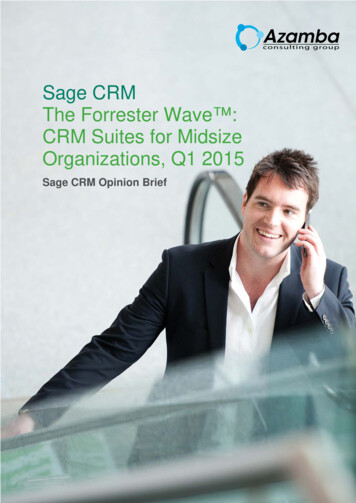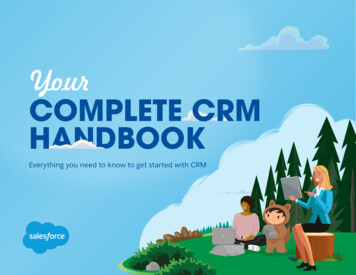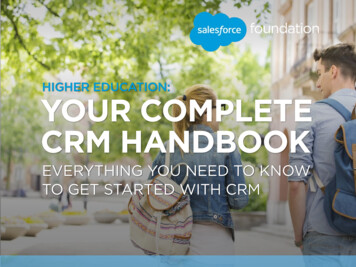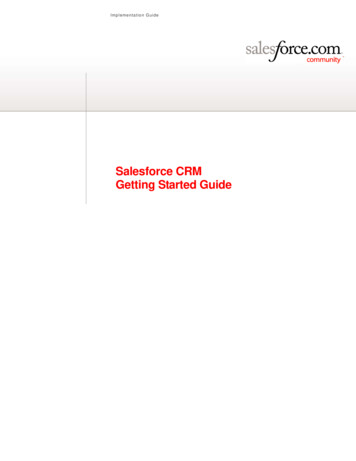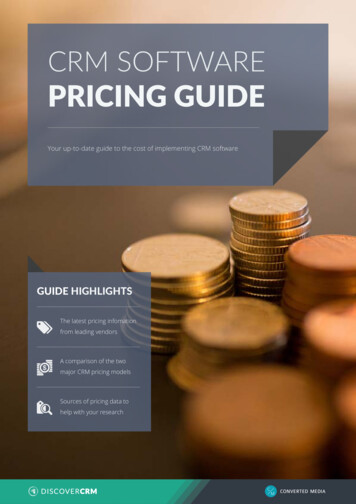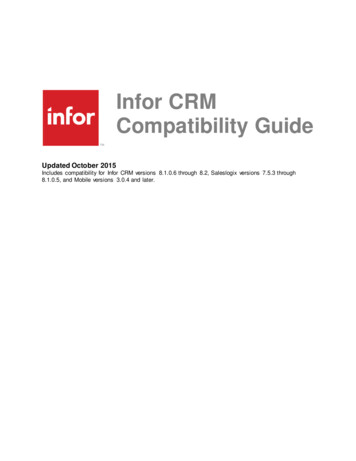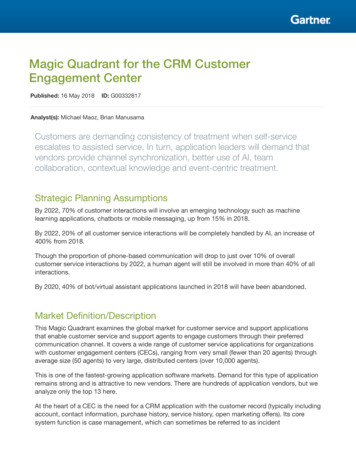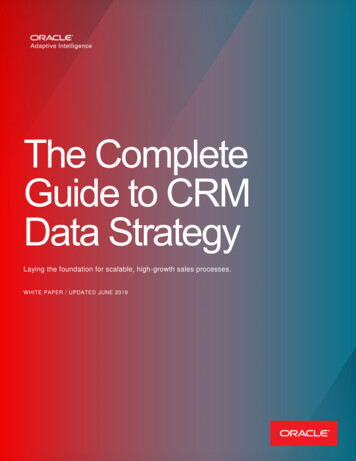
Transcription
The CompleteGuide to CRMData StrategyLaying the foundation for scalable, high-growth sales processes.WHITE PAPER / UPDATED JUNE 2019
TABLE OF CONTENTSIntroduction . 3The Data Management Landscape. 4Where is the CRM Industry Headed? . 4Why is Data Quality so Important Right Now? . 4Managing the CRM Data Foundation . 6Gathering Quality CRM Data . 6Leveraging Big Data for CRM . 6Essential Data for CRM Is Both Internal and External . 7Methods for Sourcing Data . 8External Data Providers Overview . 8Data Quality Deep Dive . 9Implementing a CRM Data Management Strategy .10Assess the Health of your CRM.10Amend Data Decay in your CRM.11Determine Augmentation Potential .12Augment Account Data .13Enable Ongoing Updates .13Maintain Quality with Governance and Stewardship .15Leverage High-Quality CRM for Operations Success .15Conclusion .162W HITE PAPER / The Complete Guide to CRM Data Strategy
INTRODUCTIONAdvances in machine learning (ML) and artificial intelligence (AI) arecausing AI-enabled technology to rapidly gain traction in sales andmarketing organizations. In B2B sales and marketing organizations, thistrend is tied to the rise of account-based marketing (ABM). As moreorganizations seek to concentrate sales and marketing resources on bestfit accounts, there is a growing need to rapidly identify high-value accountsand timely, relevant account insights. High-quality data and comprehensivedata management enables laser-focused targeting.High-quality data andcomprehensive data managementenables laser-focused targeting.AI-enabled technology, such as high-velocity data collection anddistribution into CRM systems, enables robust, automatic delivery ofvaluable insights on accounts. With personalization at scale, high-valueaccounts are the gold standard of modern revenue-generating teams.For AI-enabled technology to offer intelligence, the datasets feeding thealgorithms must be robust and high quality. Revenue-generating teamsmust prioritize comprehensive data management to ensure they have asolid foundation of company data before implementing any AI-enabledtechnology that will support their strategies. A high-quality foundation ofcompany data is paramount to revenue-generating teams wanting toseriously leverage AI.This white paper addresses how B2B sales and marketing teams cangather high-quality company data and implement basic data managementprocesses to build a strong CRM data foundation capable of supportingAI-enabled technology.3W HITE PAPER / The Complete Guide to CRM Data StrategyA high-quality foundation ofcompany data is paramount torevenue-generating teamswanting to enter the impendingage of AI in earnest.
THE DATA MANAGEMENT LANDSCAPEA look at the history of CRM and data management—and how best practices of the past can help usembrace the CRM of tomorrowWhere is the CRM Industry Headed?Maintaining customer records has been crucial, but keeping them clean and updated has alwaysposed a challenge. When company data became digitized in the 1980’s, the challenge wasexacerbated by data silos and the accelerating proliferation of dirty data. When cloud-based CRMsemerged, many of the challenges presented by clunky on-premises CRM software were mitigated, butnew ones have surfaced.While CRM is in the cloud, thedata that feeds it is not, creatingdisparate data problems.While CRM systems exist in the cloud, the data that feeds them is not, creating disparate dataproblems. In bringing CRM to the cloud, Salesforce accomplished something revolutionary, but withthe rapidly expanding influence of AI, a new revolution for CRM is already on the horizon.In the next three years, CRM customers will adopt AI-enabled technology en masse. These advanceswill catalyze a new wave of AI-enabled technologies and empower sales and marketing teams toprospect and target with greater efficiency and accuracy than ever before.Figure 1. The history of CRM begins in the age of digital antiquity when Florentine merchants sailing theMediterranean and traditional sales teams kept written records in paper ledgers. The 1950’s saw the invention ofthe Rolodex, the desktop card holder that organized contacts and companies, holding as many as a thousandrecords. In the digital age, the Rolodex became digital with ACT! It could be backed up and saved to a small disk.In the software era, Siebel Systems emerged as the CRM industry leader. Millions of records could be supported,but installed on premises. The cloud era began when Salesforce took application management off premises andput it into the cloud; data management was still done in house, however. Today, sales organizations prepare for thegolden age of AI as CRM becomes more intelligent with new applications and data cloud maturation.Why is Data Quality so Important Right Now?Ensure that large quantities of data don’t drown out insight, but result in heightened intelligence.As AI-enabled technologies begin to take hold, the datasphere is accelerating—reaching a trilliongigabytes by 2025. In the world of CRM, that translates to a lot of company data. In a reportcommissioned by Salesforce, the global market intelligence firm IDC outlined just how impactful AI willbe for CRM users. According to the report, that impact (from increased revenue) is projected to reachUS 120 billion by 2020 with US 33 billion of it from improved productivity alone.This massive impact can only occur after companies get a handle on their customer data. If a CRMsystem does not have a clean data foundation, algorithms based on that data will give unreliable4W HITE PAPER / The Complete Guide to CRM Data StrategyIf a CRM system does not have aclean data foundation, algorithmsbased on that data will giveunreliable results. Even the verybest algorithms cannot delivervaluable insights when they arebuilt on bad underlying data.
results, rendering “intelligence” essentially useless. This problem is known in computer science lingoas “garbage in, garbage out”—even the very best algorithms cannot deliver valuable insights whenthey are built on bad underlying data.Most B2B sales and marketing orgs still grapple with profound CRM data issues that prevent themfrom implementing the new wave of AI-enabled technology. According to a 2013 IBM study, 82percent of CMOs felt underprepared to deal with the data explosion (up from 71 percent in 2011). Thisis in large part because they lack necessary data management systems and scalable techniques thatcan make sense of the overwhelming amounts of data being generated every second of every day.Figure 2. CRM data hierarchy of needsWhat is the CRM Data Foundation?DEFINING THE CRM DATA FOUNDATIONAs organizations move toward greater reliance on automation to fuel their growth, data quality is increasinglyimportant. To implement AI-enabled processes in their CRM, companies must first build a solid CRM datafoundation. The data foundation must include a base of high-quality company data and a managementframework for ensuring ongoing maintenance of that level of data quality. Quality underlying data: Internal company data and external data provided by third-party vendors. Comprehensive data management: Application of a traditional master data management (MDM)framework to maintain a high quality CRM data foundation.Figure 3. The three steps overall steps to creating a high-quality CRM data foundation are data gathering,fundamental management, and master management.5W HITE PAPER / The Complete Guide to CRM Data StrategyThe CRM Data FoundationA solid data foundation in CRMhas two key components: Quality underlying data A comprehensive system forongoing management of thatcompany data.
Managing the CRM Data FoundationApply well-developed data management practices and applications to CRM data management.A Brief History of MDMData management is well-developed at enterprise companies, where data management is a maturepractice. Oracle defines MDM as a combination of applications and technologies that “consolidates,cleans, and augments corporate master data, and synchronizes it with all applications, businessprocesses, and analytical tools,” with the goal of achieving massive improvements in “operationalefficiency, reporting, and fact based decision-making.” Ultimately, the goal of applying MDM principlesis to bring order to the chaos that plagues operationally critical data.As organizations began toimplement a variety ofapplications ranging from ERP,SCM, and data warehousing, databecame increasingly siloed, andlacking a single source of truth.There was a need to definemaster data across the silos.SMB organizations have the same goals. Marketing and sales teams at SMB orgs stand to gain a lotby adopting data management tactics inspired by traditional methods. With the objective of creating asingle source of truth across various data inputs, MDM represents a powerful model.In CRM data management, application of MDM processes offers a compatible solution because itsolves the same essential root problem—siloed data. In the enterprise, data was siloed in differentorgs and across various applications such as enterprise resource planning (ERP), supply chainmanagement (SCM) and CRM.In CRM, data is disparate. While CRM software is centralized in the cloud, the data that feeds it is not.The essential structure of MDM offers an excellent framework for amending the problems created bysiloed company data.Out of this, the field of masterdata management (MDM)emerged as an approach toreaching a single point of truthfrom large datasets. MDMprovides a reliable foundation ofdata by implementing methodsand rules of governance thatensure consistent data qualityacross multiple applications.GATHERING QUALITY CRM DATABuilding a base of high-quality company dataLeveraging Big Data for CRMHow is the evolving datasphere shaping the way organizations are amassing customer data?At the core of any CRM system is trusted data. To grapple with the overwhelming quantity of companydata in the system, it’s important to understand the four Vs of big data: velocity, veracity, volume, andvariety. When applied to CRM, these four Vs can help inform selection of a data vendor and setexpectations for incorporation of customer data. For advanced analysis and modeling, it’s necessaryto combine big data from external sources with existing CRM data.Trusted data is at the core of anyCRM system. As the dataspheregrows, the nature andexpectations of company dataevolve with it.Figure 4. Volume, velocity, veracity, and variety are the four Vs of big data in CRM.6W HITE PAPER / The Complete Guide to CRM Data Strategy
As the datasphere grows, the nature and expectations of company data evolve with it.NATURE OF DATAVolumeData grows at a nearly exponential rate because it is produced and captured morefrequently.VarietyThe sources of CRM data are diversifying all the time. CRMs started by indexing basicinformation such as company name and location, but now CRM data can include socialmedia engagement or buying signals such as an executive hire or expansion to a newlocation.EXPECTATIONS OF DATAVeracityWith advances in natural language processing and human analysis, company data ismore accurate than ever. CRMs can reflect changes in account information from multiplesources to stay up-to-date.VelocityData can now be delivered into sales and marketing team workflows in real-time, andwith regular, automatic updates.Essential Data for CRM Is Both Internal and ExternalIn its most rudimentary form, the foundation of company data is simply a compilation of two types ofdata: internal and external.Internal customer data is gathered internally from your CRM, marketing automation, and useranalytics platforms. This covers a customer’s digital behavior—including downloading content, fillingout a form, or using a new feature—as well as interactions with your sales and customer successteams.Figure 5. Internal customer data includes marketing behavior, lead behavior, user activity, and more.External company data is acquired from third-party sources, either from subscriptions or listpurchases. External data typ
While CRM systems exist in the cloud, the data that feeds them is not, creating disparate data problems. In bringing CRM to the cloud, Salesforce accomplished something revolutionary, but with the rapidly expanding influence of AI, a new revolution for CRM is already on the horizon.
